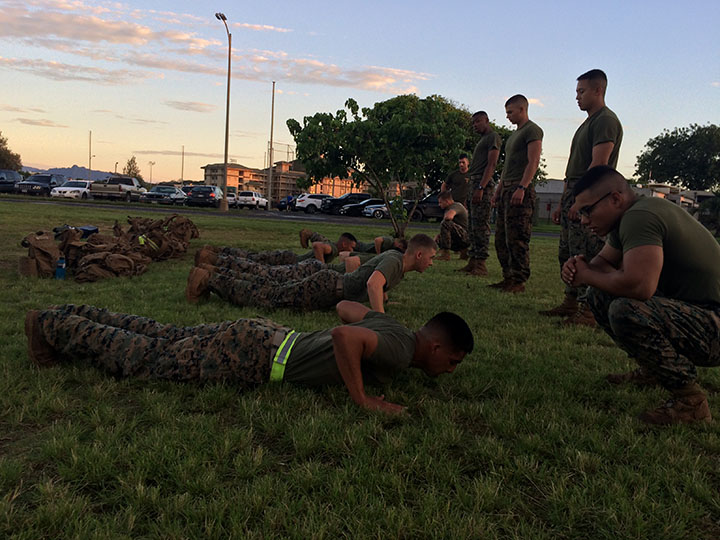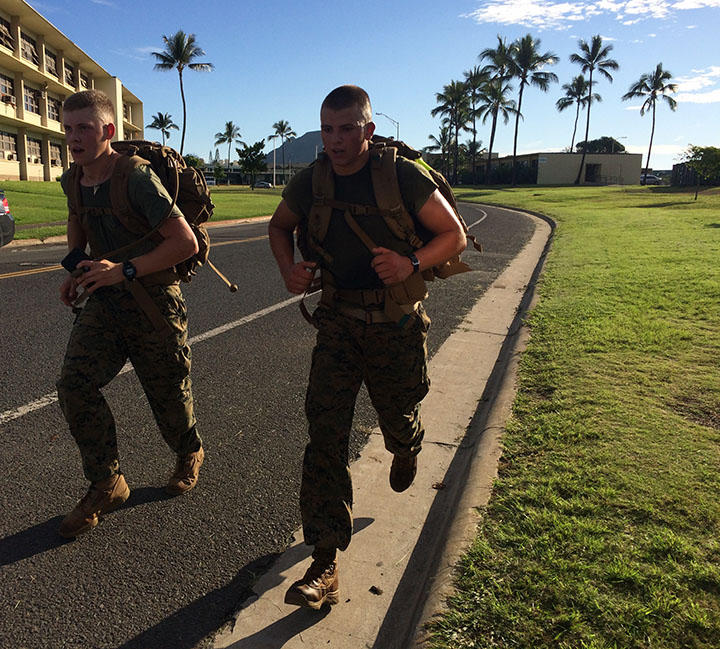
By Rob Shaul, Founder
Background
In January 2018 MTI identified 7 Major Problems with the Proposed Army Combat Readiness Test and developed/published the Soldier-Athlete Fitness Test (SAFT) – our proposed replacement for the US Army APFT, and the USMC PFT.
After a prescribed, simple warm up, here are the SAFT events:
- Max Rep Bodyweight Pull Ups in 2 Minutes
- Max Rep Hand Release Push Ups in 60 Seconds
- Max Rep Pull Up Bar Heel Tap in 60 Seconds
- MTI Tactical Athlete Work Capacity Fitness Assessment (All Athletes Run This together – Entire Event Takes 11 Minutes)
Rest 15 Minutes Before Starting Ruck Run - 3 Mile Ruck Run for Time @ 40# ruck (All Athletes Run This together)
We feel the SAFT offers several advantages over the current APFT, USMC PFT, and many other military fitness assessments:
- Requires limited equipment
- Better assesses Mission-Direct military fitness – especially loaded work capacity and movement under load
- Is easy to Administer and Simple to Score
Fitness Attributes Assessed by Each Event
|
Fitness Attribute |
Event |
|
Upper Body Pull Strength |
Max Reps Bodyweight Pull Ups in 2 Minutes Strict Pull Ups – no kipping – full elbow lockout to bottom of chin touching pull up bar. No time limit. Athlete can “rest” in the down position – hanging from the pull up bar. Both hands must remain on the bar at all times. |
|
Upper Body Press Strength |
Max Rep Hand Release Push Ups in 60 Seconds Hands up to elbows locked out. Body must come up stiff (no midsection sag) – Athlete can “rest” in the down position (laying on the ground) |
|
Core Strength |
Max Rep Pull Up Bar Heel Tap in 60 Seconds No swinging backward in the bottom position. Each rep begins with the athlete hanging still from the pull up bar with his elbows at full lockout and legs hanging straight. Athlete can rest in the down position hanging from the pull up bar. |
|
Mission-Direct Work Capacity |
|
|
Mission-Direct Endurance |
3-Mile Ruck Run for Time at 40# Ruck. Many schools and selections (Ranger, Airborne, SFAS, Expert Infantryman Badge, etc.) use a 10 or 12 mile ruck as part of their initial “gate” assessment or another scored event. For this reason, I’ve always wondered why a ruck event was not part of the APFT. The 3-Mile event here will address this. Three miles is shorter than the commonly assessed 10 or 12 miles and is long enough to separate performances. |

Putting 10 Marines Through the SAFT
On April 4, 2018, ten US Marines with the Alpha, Charlie and Weapons Companies of 1st Battalion, 3rd Marines stationed at USMC Base Hawaii completed the entire assessment.
We had contacted Marines stationed at the Base prior and asked for volunteers to try the assessment, and members of the 1/3 responded positively.
Military members from several US branches have completed individual elements of the SAFT – especially the MTI Tactical Work Capacity Assessment, but this was the first time actual military members conducted the entire assessment as designed.
Scoring:
50 Points Total
General Score Total Points
Poor 0-20
Good 21-35
Excellent 36-50
Results:

Discussion
Overall, the Assessment went well for its first real-world application. The final scoring appears slightly inflated.
Ideally for a group of 10 athletes, with a typical curve, two would score “Poor”, two would score “Excellent” and 6 would score “Good.” In this case, we had four “Excellent” scores, four “Good” and just two “Poor”.
Range of motion issues with the Hand Release Push Ups (see below) could account for some of this. Stricter enforcement or a different exercise would likely lower the Push Up score and decrease the overall results.
As well, the Pull Up Bar Heel Tap exercise range of motion was not consistently enforced. Several times I corrected athletes for tapping their toes above the pull up bar, not their heels. Tapping heels are harder, and this being better enforced may have reduced scores.
Finally, most of the Marines who completed the SAFT volunteered and thus were likely pre-disposed toward fitness and curious at trying a new assessment – meaning as a group there was likely much more fit than the average population.

Lessons Learned
1) Range of Movement Issues with the Hand Release Push Ups
From the score chart above, the Hand Release Push Up Scores were suspiciously high. The issue was the range of motion during completion of the Hand Release Push Ups – specifically, just raising the torso and not bring up the butt/midsection in one motion during the exercise. I demonstrated the technique prior to the assessment, but in watching the Marines perform the assessment, it was clear the message didn’t get through.
Frustratingly, I’d chosen Hand Release Push Ups over regular push ups because of exercise technique/range of motion issues with regular push ups. Plus – Hand Release Push Ups are simply more difficult. Done strict, Hand Release Push Ups are a great upper body pressing exercise.
Often when there are technique and/or range of movement issues with an assessment exercise, coaches blame the athletes. However, we like to look at the exercise … is there a more simple, more direct exercise we can deploy to address the issue?
In this case, what comes to mind is metronome Hand Release or regular push ups like those deployed at Ranger School. Slowing the exercise down with a metronome count, and ending the exercise for the athlete when he/she can’t make the next count may address the range of motion issue. This could also work for the Strict Pull Up event.
The only problem with the metronome counting is it adds another layer of equipment – test administrators will need a smartphone and perhaps speakers so athletes can hear. Also, this may extend the event beyond it’s prescribed 60 seconds for push ups and 2 minutes for pull ups. We’ll need to do some testing.
2) Ruck Loading @ 40 Pounds
The prescribed 3-Mile Ruck Run loading for the SAFT is 40 pounds. Even though this was disseminated to the Marines prior to the assessment, several either didn’t get the message or simply didn’t weigh their rucks prior.
Many of the participating marines brought rucks with pre-made 45-pound “bricks” – duck-taped bags of sand they regularly use for ruck training. My sense is 45 pounds is a common ruck training load – we use this load ourselves often, and perhaps an easy fix is simply to use 45 pounds as the loading for this event.
From an equipment issue, ruck load is the most complicated for the SAFT. A platoon may have 1 or 2 ruck scales, but these may or may not be readily available and this complicates getting the road correct, obviously. Adding in the different types of rucks, and extra pouches, etc. only complicates things.
Moving forward, a possible change to the SAFT is simply making the load for the Ruck Run 45 pounds, minus the ruck.
3) Overall Assessment Duration
The Assessment ran long – beyond the 105 minutes I had hoped, to around 120 minutes total to complete by the time the final athlete finished the ruck run.
Part of this duration can be explained by the Marines’ unfamiliarity with the assessment and several of the events – including the MTI Work Capacity Assessment, Hand Release Push Ups and Pull Up Bar Heel Tap.
Issues concerning ruck load also slowed us down as we had to shift hear around to get rucks close to the 40-pound prescribed load. More communication ahead of time and prescribing a 45-pound ruck load will help address these delays.
As well, the current warm up (see below) ran beyond the 10 minutes I’d hoped, and a possible change will be to cut the warm up to 3 rounds and eliminate the Lat + Pec Stretch.
Also, the 15-minute rest between the MTI Tactical Athlete Work Capacity Assessment and the 3-Mile Ruck Run can be cut to 10 minutes.

Potential SAFT Changes
1) Fix the Hand Release Push Up event – either by being more specific about range of motion, conducting it on a count or metronome, or changing the exercise altogether.
2) Reduce the Warm Up – to 3 Rounds and cut the Lat + Pec Stretch to shorten it.
3) Prescribe a 45-pound Ruck Load – not including the Ruck, for the Ruck Run event.
Questions/Comments/Feedback? Email rob@mtntactical.com

You Might Also Like 7 Major Problems with the Proposed Army Combat Readiness Test & Our Proposed Replacement for the APFT
STAY UPDATED
Sign-up for our BETA newsletter. Training tips, research updates, videos and articles - and we’ll never sell your info.
